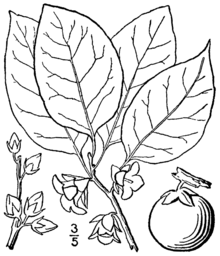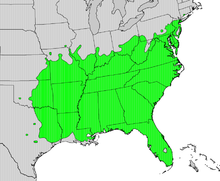American persimmon
| Diospyros virginiana | |
|---|---|
 |
|
| Botanical details of buds, flowers and fruit | |
| Scientific classification | |
| Kingdom: | Plantae |
| (unranked): | Angiosperms |
| (unranked): | Eudicots |
| (unranked): | Asterids |
| Order: | Ericales |
| Family: | Ebenaceae |
| Genus: | Diospyros |
| Species: | D. virginiana |
| Binomial name | |
|
Diospyros virginiana L. |
|
 |
|
| Distribution map of the American persimmon | |
| Synonyms | |
|
Diospyros mosieri S.F.Blake |
|
See also SIMMON (a software program)
Diospyros mosieri S.F.Blake
Diospyros virginiana is a persimmon species commonly called the American persimmon,common persimmon,eastern persimmon, "'simmon", "possumwood", or "sugar-plum". It ranges from southern Connecticut/Long Island to Florida, and west to Texas, Louisiana, Oklahoma, Kansas, and Iowa. The tree grows wild but has been cultivated for its fruit and wood since prehistoric times by Native Americans.
Diospyros virginiana grows through 20 m (66 ft), in well-drained soil. In summer, this species produces fragrant flowers which are dioecious, so one must have both male and female plants to obtain fruit. Most cultivars are parthenocarpic (setting seedless fruit without pollination). The flowers are pollinated by insects and wind. Fruiting typically begins when the tree is about 6 years old.
The fruit is round or oval and usually orange-yellow, sometimes bluish, and from 2 to 6 cm (0.79 to 2.4 in) in diameter. In the U.S. South and Midwest, the fruits are referred to as simply persimmons or "'simmons", and are popular in desserts and cuisine.
Commercial varieties include the very productive Early Golden, the productive John Rick, Miller, Woolbright and the Ennis, a seedless variety. Another nickname of the American persimmon, 'date-plum' also refers to a persimmon species found in South Asia, Diospyros lotus.
It is a small tree usually 30 through 80 feet (10 through 24 meters) in height, with a short, slender trunk and spreading, often pendulous branches, which form a broad or narrow, round-topped canopy. The roots are thick, fleshy and stoloniferous. This species as has a shrubby growth form. This plant has oval entire leaves, and unisexual flowers on short stalks. In the male flowers, which are numerous, the stamens are sixteen in number and arranged in pairs; the female flowers are solitary, with traces of stamens, and a smooth ovary with one ovule in each of the eight cells—the ovary is surmounted by four styles, which are hairy at the base. The fruit-stalk is very short, bearing a subglobose fruit an inch in diameter or a bit larger, of an orange-yellow color, ranging to bluish, and with a sweetish astringent pulp. It is surrounded at the base by the persistent calyx-lobes, which increase in size as the fruit ripens. The astringency renders the fruit somewhat unpalatable, but after it has been subjected to the action of frost, or has become partially rotted or "bletted" like a medlar, its flavor is improved.
...
Wikipedia
